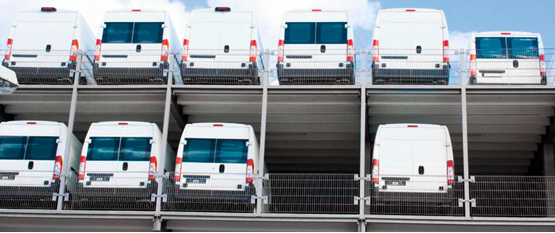One auction expert says this could be the strongest super-heated summer marketplace on record.
The summer heatwave was matched by the average price of used vans in June, as the big auction companies reported healthy year-on-year rises.
Manheim saw the average selling price for vans sold at its auctions rise by 8.5% year-on-year in June, to £5,121.98.
De-fleeted volumes were expected to soften over the summer months and in fact they reduced by 12% in June, with a year-on-year reduction of 4% against May 2016.
Matthew Davock, head of LCV at Manheim, said: “Overall performance in June was very encouraging and when comparing month-on-month and year-on-year statistics, this further demonstrates we are witnessing a super-heated market place in what, historically, can be a challenging period.”
On average, vans sold at Manheim in June were four months younger than a year ago, with an average age of 61 months, and average mileage was down 4.3% year-on-year to 76,934.
However, since January the average age and mileage continues to rise month-on-month.

Davock said: “The 2017 marketplace continues to show strength and consistency, but month-on-month volume levels are proving very difficult to predict what will happen next.
"With two quarters complete, who would have predicted the volume shifts we have witnessed, record de-fleeted volumes during Q1, followed by a staggering 27% less volume when you compare Q2 against Q1’s marketplace?
“The first half of 2017 has been incredible. Feedback from buyers in June was mainly positive, with many reporting good retail activity and June being the strongest retail month of Q2 compared to a reported slower April and May period.
“Overall, June provided strong and positive buyer activity in our online and auction lanes, physical buyer base attending sales increased by 8% and our online attendees have shown 16% uplift against May’s numbers.
“The marketplace remains positive and looking ahead, I predict de-fleeted volumes to be similar to June.
"If retail activity continues as expected, this will further fuel what could be the strongest and very much super-heated summer marketplace on record.”
At BCA, year-on-year values remain well ahead, up by £551, equivalent to a 9.3% increase over the period.
Average age and mileage continued to decline, reflecting the growing share of corporate stock sold as well as the higher volumes of younger rental stock seen over recent months.
BCA LCV operations director Duncan Ward commented: “History shows us that the commercial vehicle market typically slows over the summer months and we would expect to see pressure continuing on average values between now and the new registration plate in September.
“While average selling price appears resilient, this is largely due to the influence of a younger, lower mileage profile of vehicles currently reaching the market and the growing volume of corporate stock handled by BCA.
“The model mix continues to change as rental volumes ease and 4x4 double-cab volumes continue to rise. This sector continues to experience price pressure and this can make guide values look overly optimistic.
"Condition and specification remain as important as ever and sellers should be aware that it is vital to appraise and value vehicles accurately to reflect current market sentiment.”
Steve Botfield, senior editor, commercial vehicles and motorcycles at CAP Red Book, said with a bank holiday at the end of May, most of the schools closed for the summer half-term holidays and a general election to boot, a certain amount of disruption to businesses was perhaps to be expected in June.
He said: “From our perspective, as we toured the country attending auctions, it certainly seemed like a month of two halves.
"Similar to the morning after the election as political pundits tried to make sense of ‘what just happened’, we, too, were baffled trying to make sense over what we were witnessing at auctions and where the used van market was heading.
“The attendance levels were certainly lower at many of the auctions we attended during the first couple of weeks of June but they did pick up considerably as the month progressed.
“We couldn’t help but notice the wildly conflicting reports over attendance levels and bidding activity at different sales across the country, even at auctions held on the same day.
"However, as the month progressed, we began to see a marked improvement in sales volume and only a marginal downturn in market prices.
"The overall weighted average performance across all LCV sectors was down by around 1% with attendance levels and bidding activity remaining patchy throughout the month.”
Botfield added: “As we head toward the mid-point of the year the rate at which three- to four-year-old used LCV stock is entering the wholesale market does not appear to reflect the historic growth in new registrations as reported by the Society of Motor Manufacturers and Traders (SMMT).
"This is fuelling speculation that leasing companies are moving away from the traditional three-year leasing model or that operators are holding back on vehicle replacement and extending contracts due to the current economic climate.”
Andy Picton, chief commercial vehicle editor at Glass’s Guide, said June saw a 1.2% month-on-month reduction in the volumes sold at auction.
However, this was 0.9% up on the same point last year. Some 71.7% of these sold at the first time of asking (69.7% – June 2016) reflecting an oversupply of stock to the marketplace and a quieter summer period, where only the very best stock is in demand.
Average stock age for those sold in June reduced slightly from 62.2 months in May to 61.3 months and now stands at nearly six months younger than at the same point last year.
Average mileage of those sold stood at 72,943 miles, down from 74,730 miles last month and more than 4,300 miles lower than last June.
The average sales price increased by more than 2.0% in June and now stands at in excess of 28% of its original cost new, while year-on-year prices reflect an increase of 8.7% or an extra £451.
Picton said: “With supplies of stock to the auctions continuing to rise, there is great pressure on vendors to supply quality stock valued in line with market expectations.
"Demand for tired and damaged stock is limited, while the small numbers in A1 condition become more expensive. This has led some buyers to now seek their next purchase away from the auctions.”
Picton said although the used market remains robust, first time conversions of under two-year-old stock fell by nearly 13% overall, with those in the under 2.6-tonnes GVW sector showing the sharpest decline.
Conversion rates here fell from 80% in May to 62% in June.
First time conversions in the medium panel van sector increased by 106 units in June and were also of a lower average age. The recorded mileage of those sold was also lower than that recorded in May.
Fall in LVC sales not a cause for concern
Alex Wright, MD of Shoreham Vehicle Auctions (SVA), has told sellers the fall in new light commercial sales is nothing to be frightened of.
New LCV sales up to 3.5-tonnes GVW have fallen by 5% (7,689 units) in the first five months of 2017 as expanding smaller companies which are concerned at the outcome of the election and Brexit are spending £10,000-£15,000 on a good quality used van rather than buying or financing £25,000-30,000 to buy a new one.
This spells good news for the used market as the demand for one- to three-year-old used LCVs is set to grow over the coming two years until the true results of Brexit are realised.
Wright said: “The light commercial market is well tuned to the current economy such as low interest rates, low unemployment figures, higher inflation and a falling Sterling.
"These current economic factors plus the election and Brexit are all enough for an SME to switch from a new to a used purchase for the time simply to manage their risk.
“Cashflow is king and they are able to change their purchasing decisions swiftly to protect their cash in the bank but not preventing them growing their businesses.”
Wright said the good news is that there are no signs of larger companies either putting new van purchases on hold or dramatically increasing their used replacement cycles as they did between 2009 and 2013.
SVA is still seeing a steady flow of three- to four-year-old used ex-fleet stock coming into the market, which will help satisfy this demand from SMEs.
There is also a sufficient price gap between the nearly-new demonstrator stock and the three-year-old van market not to damage prices of the latter.
SVA’s conversion rates have remained consistent at between 80-90% at most of its auctions in 2017.
“This price gap means that independent dealers are buying in three-year-old stock and older to complement some of the newer stock they are able to source from the manufacturers.
"This gives them a mixed range of stock which helps them manage their own businesses more effectively,” said Wright.
SVA is predicting a settled used market entering July and August with demand growing and prices remaining at their current levels rather than suffering from the normal summer dip.
Only if new van sales plummet in the coming months will used prices rise above inflation again as demand threatens to exceed supply.
















Login to comment
Comments
No comments have been made yet.